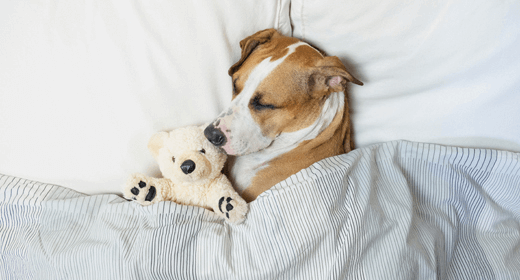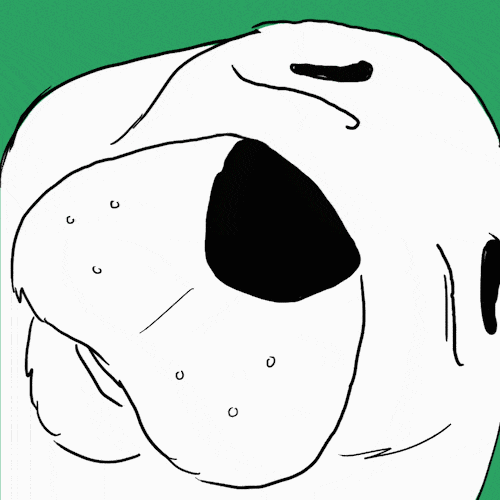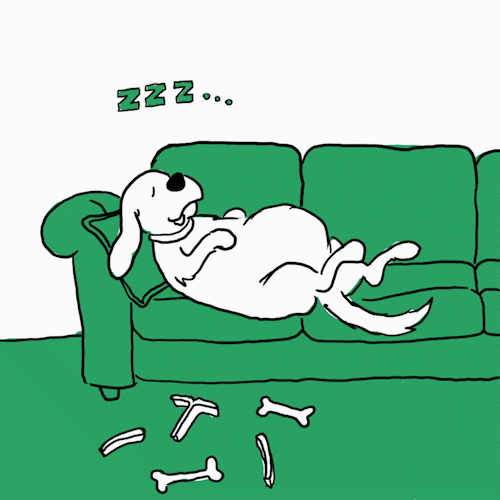

We may often envy our dogs for the kind of life they lead. Chilled, relaxed, and always well-rested. After sleeping like babies all night, dogs have the ability to nap throughout the day. You will find them basking under the sun, dozing off on the couch, or just napping next to your feet. When they do wake up after they’ve had their fat naps, they are full of energy and ready for some serious playtime.
Many animals, like dogs, sleep differently than we humans do. This is a very common reason for dog parents to wonder why my dog is always sleeping. Is my dog sleeping a lot or not enough? If you are wondering how much sleep do dogs need, there is more than one answer to this question. Just like how our sleep cycles change throughout our lives depending on our age, health, lifestyle, etc, a dog’s sleep cycle also changes depending on its age, health, and lifestyle. Keep reading to learn more about how long do dogs sleep, so it’s easier for you to understand your floof’s sleep patterns.
Dogs need a considerable amount of sleep; a lot more than we do. Additionally, carnivores like dogs sleep a lot more than herbivores since sleep is more dangerous for prey animals. The total number of hours a dog needs to sleep for varies on different factors such as its age, its health condition, and the kind of life it leads. Out of all these factors, age matters the most.
Dogs can sleep for around 12-14 hours each day, but puppies can clock in even more hours. This is because the body needs a lot of rest and repair during the first few months of life. Let’s take a look at how age affects the sleep cycle of dogs.
Puppies need to sleep for as long as their body needs to facilitate growth and repair. It is completely normal if your puppy sleeps for most of the day. In fact, puppies tend to sleep more throughout the day and less through the night.
Most adult dogs tend to sleep for anywhere between 8 to 13 hours, averaging around 11 hours each day. Yes, that’s a lot but that’s also a charm for these cute, cuddly floofs. Adult dogs tend to sleep for longer during the night depending on their and their pet parent’s schedule. However, napping for them is equally important. That being said, sleeping for a few hours during the day is absolutely normal.
Senior dogs and middle-aged dogs sleep as much as puppies. They tend to not wake up through the night and nap for a considerable number of hours throughout the day. These hours of sleep make sure that their body is well rested and recovering well as their body continues to age.
We now know that dogs, on average, can sleep for 15 hours a day irrespective of their age. However, every dog is different and will stick to a different routine which is okay. As a pet parent, you will soon understand your floof’s sleeping cycle and how its body functions.
If you do start worrying about your floof sleeping for too long, do not hesitate to contact your vet. It is always better to clear your doubts and take your furry friend to the doctor for a check-up and be sure. Another cause for concern that should be kept in mind is your dog sleeping for longer than usual. This could be a sign of underlying causes such as diabetes, dog depression, anxiety, and more. This is why a visit to the vet whenever you are worried is highly recommended.
There could be many reasons as to why your dog is sleeping so much. Our first thought is always an underlying disease that should be checked out by the vet. While this is highly recommended and also very common, many other reasons can make your dog sleep for very long.
If you’re wondering “Why is my dog always sleeping?”, the answer could be as simple as boredom. Sometimes dogs will resort to sleeping simply because they do not have anything to do. Apart from boredom, stress and anxiety are also major reasons for dogs sleeping too much. If your dog is anxious, you will notice it being lethargic and falling asleep often. The best way to combat this is to establish a routine and include some wholesome playtime.
Your dog can be susceptible to hyperglycaemia if its body is unable to produce the minimum amount of insulin needed. Certain dog breeds are at a higher risk of this disease as compared to other breeds. Visit your vet to diagnose conditions like this early and do the needful.
Viral infections in dogs are highly contagious and can affect your floof’s body greatly. Because of viral infections, your floof’s body will be unable to absorb any nutrients and will leave it dehydrated. Other than that, your floof will also suffer from a lack of protein and recovering from this disease will take some time. Resort to early puppy vaccination to keep occurrences as such at bay.
This infection caused by bacteria is highly contagious and your dog can get this disease easily through direct contact with urine from other dogs. This disease can also be passed on by humans. Again, this disease can drain your floof’s body of energy resulting in it falling asleep way too often.
Poisoning is a reason that should not be neglected by dog owners. If your dog is not trained and will eat anything palatable, it is at risk of poisoning itself. Other than that, many human foods are also poisonous to dogs. Avocados, spices, coffee, cheese, and more are foods that should not be fed to dogs, especially when you're pampering your floof.
Now that you know how much sleep do dogs need on average, you can notice any sudden changes in your dog’s sleep patterns. See a vet immediately if you suspect any illness or disease.
A dog’s sleep cycle depends on its age and lifestyle. For example, it is very normal for a puppy to sleep for around 20 hours a day since their bodies need to rest and repair.
Sometimes, dogs keep sleeping all day because they are bored. The best way to help your dogs in situations as such is to establish a routine that also includes some exciting playtime.
Judging by how much sleep do dogs need, a dog may be stressed if it is sleeping for way too long as compared to how much it should. Another sign of stress in dogs is lethargy.




In the realm of pet care and canine health, vitamin B for dogs emerges as one of the most important. While they might not always garner as much attention as other nutrients, the impact of vitamin B on your dog's well-being is profound. From supporting energy metabolism to promoting a healthy coat, the B-complex vitamins play a crucial role in keeping your furry friend in top-notch condition. Join us as we delve into the world of vitamin B for dogs, exploring its multifaceted benefits and uncovering the sources that can contribute to your pup's overall vitality.
Vitamin B is a group of water-soluble vitamins, including B1 (thiamine), B2 (riboflavin), B3 (niacin), B5 (pantothenic acid), B6 (pyridoxine), B7 (biotin), B9 (folate), and B12 (cobalamin). These act as coenzymes, partnering with enzymes to facilitate critical biochemical reactions that drive cellular processes. For instance, they are pivotal in the breakdown of nutrients, ensuring that the energy derived from food is efficiently utilised by your dog's body. Additionally, B-complex vitamins are key players in the synthesis of neurotransmitters, aiding in the transmission of signals between nerve cells and supporting cognitive function. While dogs can produce some B vitamins internally, a well-rounded diet with external sources ensures they receive optimal levels, fortifying their biological functions and contributing to a vibrant and energetic life.
Absolutely, dogs not only can but should have vitamin B as an integral component of their dietary intake. While dogs possess the capability to internally synthesise certain B vitamins, such as B3 and B6, others like vitamin B12 for dogs must be sourced from their diet. This dietary supplementation is crucial as these vitamins play pivotal roles in metabolic functions, nerve health, and the synthesis of essential biomolecules. Ensuring a consistent and balanced intake of vitamin B is a proactive measure to support your dog's overall health, contributing to its vitality.
Certainly, vitamin B is exceptionally beneficial for dogs. Each B vitamin plays a distinctive role in supporting various facets of your dog's health, encompassing crucial functions such as energy production, cognitive well-being, and the maintenance of a glossy coat. Dogs experiencing deficiencies in specific B vitamins might manifest symptoms such as lethargy, lacklustre coat condition, and, in severe cases, neurological issues. Prioritising the incorporation of an appropriate amount of vitamin B into your dog's diet is pivotal for sustaining its vitality, promoting optimal organ function, and ensuring they lead a vibrant and active life.
In the often-underestimated landscape of canine nutrition, the B-complex vitamins emerge as silent yet vital allies. Before we unravel their diverse benefits, ranging from promoting energy metabolism to supporting skin and coat health, let us delve into the crucial role of vitamin B for puppies and dogs in their overall well-being.
Energy metabolism
B vitamins play a key role in converting food into energy. Thiamine (B1), riboflavin (B2), niacin (B3), pantothenic acid (B5), and pyridoxine (B6) contribute to the metabolic processes that provide energy for your dog's daily activities. A well-regulated energy metabolism ensures that your canine companions maintain an optimal level of activity and vitality throughout their daily routines.
Healthy nervous system
B vitamins are essential for maintaining a healthy nervous system. They play a role in nerve function and help prevent neurological issues in dogs. Ensuring a sufficient intake of B vitamins promotes not only a robust nervous system but also contributes to improved cognitive function, fostering a sharper and more alert companion.
Skin and coat health
Biotin (B7) is particularly known for its role in promoting skin and coat health. A biotin deficiency can lead to skin problems and a dull coat. Incorporating biotin-rich foods into your dog's diet not only enhances its appearance but also contributes to overall well-being, ensuring a radiant and healthy coat.
Red blood cell formation
Vitamin B9 and vitamin B12 benefits for dogs include the formation of red blood cells, which are vital for oxygen transport throughout the body. Adequate levels of these B vitamins contribute not only to your dog's physical endurance but also support its overall cardiovascular health, ensuring efficient oxygenation of tissues.
Cell division
Several B vitamins, including folate and cobalamin, are involved in cell division, contributing to the growth and maintenance of tissues. This intricate role in cell division highlights the importance of B vitamins in the ongoing repair and renewal processes within your dog's body, promoting longevity and sustained health.
Ensuring your dog receives an ample supply of B-complex vitamins involves incorporating a variety of nutrient-rich foods into its diet. Here are some canine-friendly options:
Meat: Lean meats, such as chicken and turkey, are excellent sources of various B vitamins, including niacin, pyridoxine, and cobalamin. Incorporating these lean protein sources into your dog's diet not only provides essential B vitamins for energy metabolism but also ensures they receive high-quality protein for muscle maintenance and overall vitality.
Liver: Organ meats, especially liver, are rich in B vitamins, particularly cobalamin and folate. However, the liver should be fed in moderation due to its high vitamin A content. While liver offers a nutrient-dense addition to your dog's diet, moderation is key to prevent excessive vitamin A intake, maintaining a balanced and healthy nutritional profile.
Eggs: Eggs are a good source of riboflavin, biotin, and cobalamin. They can be served boiled or scrambled as a nutritious treat. Including eggs in your dog's diet not only provides a diverse range of B vitamins but also offers a delicious and versatile option that can be tailored to your pet's taste preferences.
Leafy greens: Vegetables like spinach and kale provide folate and other B vitamins. These can be lightly cooked and added to your dog's meals. Adding these nutrient-rich leafy greens to your dog's diet not only contributes to its B vitamin intake but also introduces essential antioxidants and fibre, supporting overall digestive health.
Whole grains: Brown rice and oats are examples of whole grains that contain B vitamins, contributing to your dog's overall nutrient intake. Including whole grains in your dog's diet not only provides a sustainable source of energy but also ensures a steady supply of B vitamins for various bodily functions, fostering a well-rounded and balanced nutritional profile.
In the nutritional narrative for our canine friends, the B-complex vitamins are heroes, weaving a tale of energy, vitality, and overall well-being. As you curate meals, let the B vitamins take centre stage, offering not just nourishment but a key ingredient in the recipe for a thriving, tail-wagging companion.